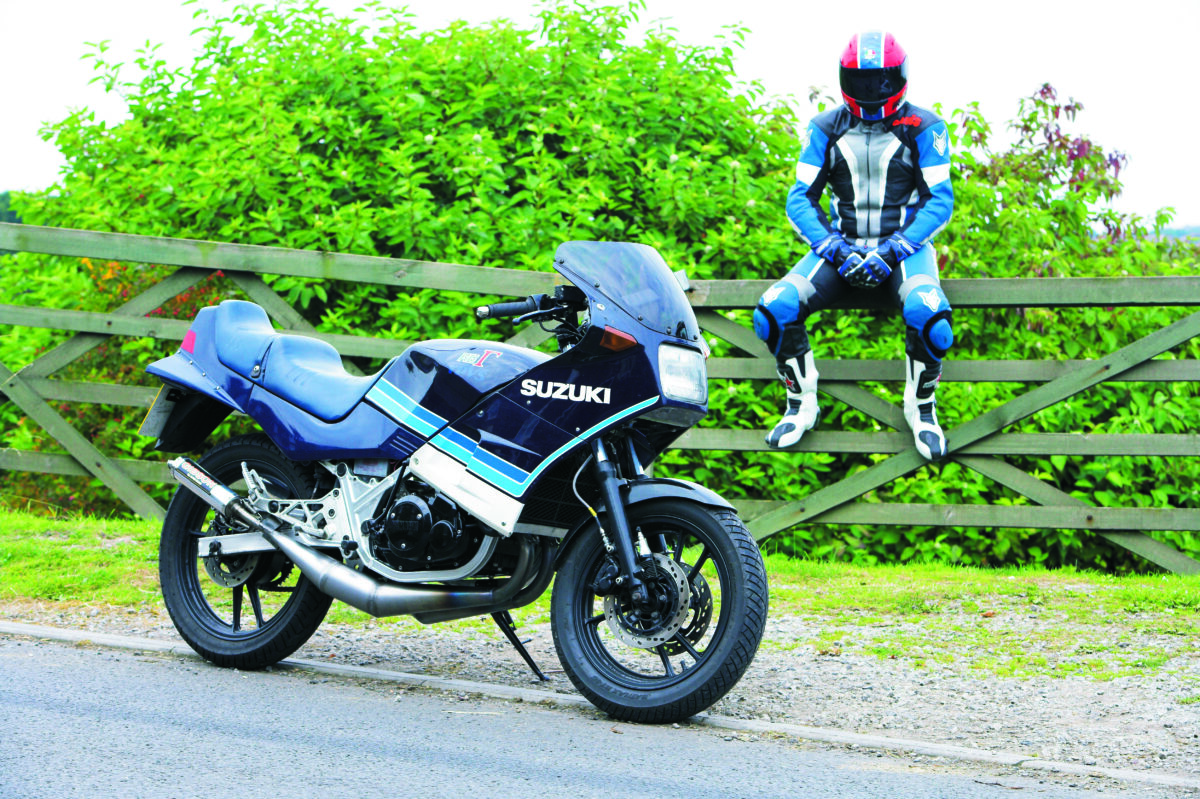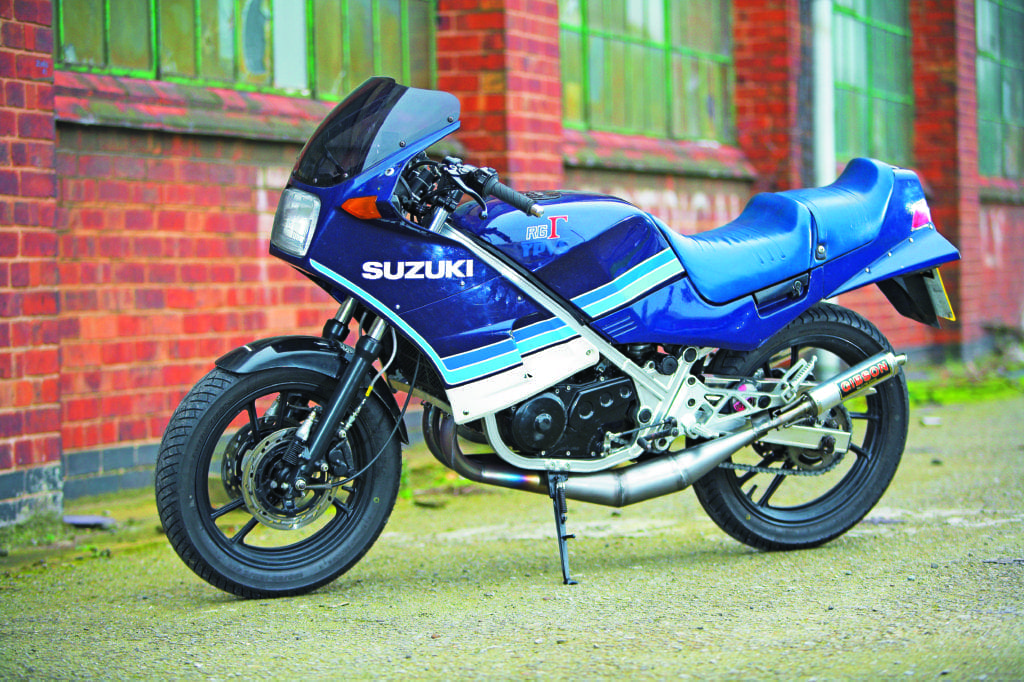
The formula for any truly great sporting machine is an easy one to concoct, despite many trying and failing in the past. The secret is to not over egg the pudding, simply use a light and agile chassis allied to an easy to use engine, all held to the tarmac by good handling and sweet manners. We go in search of the perfect recipe.

LOVE AT FIRST SIGHT, ELSIE MEETS SUZY
All that is required is present and correct in a well assembled Yammagamma, the original chassis being little more than a scaled down GSX-R frame and cycle parts, while being 20 per cent stiffer, and around 30 per cent lighter, than the old style Yamaha steel tubed frame. By wrapping the highly respected Yam twin engine in Suzuki’s more than capable allow beam chassis, a hybrid worthy of legend was born.
To keep up to date everything Classic Motorcycle Mechanics, like our Facebook page or follow us on Twitter here.
The transplant isn’t a hard one either, the space within the RG250’s frame tubes is bang on for the Yam lump and, all that is needed engineering wise is a few easily fabricated brackets and spacers before the power valve engine can be securely bolted in. The result is a factory built look with just the extreme curve of the hose from the water pump to the lower radiator coupling giving the game away. The Yamaha engine sits in the chassis as if made for the task, while all of the ancillary parts fit without looking out of place too. Even the YPVS exhausts fit a treat, making the finished article look every bit the factory-produced machine it could easily be.

The creation of the Yammagamma is a natural progression for the RD350 YPVS engine, effectively finishing off the work Yamaha never started, the original machine hardly moving on during the decade of its existence sticking firmly with technology either borrowed from the 70s or built to strict budget requirements. Quite why the tuning fork brand never saw fit to create such a beast one will never know, as the engine was already in existence and ripe for further development, and it’s a safe bet that it would have been far more successful than the underpowered and overweight RD500LC.
Of course, Yamaha, along with the rest of the Jap brigade, did create some stunning quarter-litre machines as the 80s wrapped up and the 90s unfolded, but those in the know appreciate that there is rarely a substitute for capacity and, on the road at least, a 350cc engine will always feel far stronger than a 250cc one, even if the latter does produce stunning levels of horsepower. It’s that big punch that the 64mm pistons give, over and above items with a draft 100cc less, that does it.
To keep up to date everything Classic Motorcycle Mechanics, like our Facebook page or follow us on Twitter here.
The two massive kicks every time the crank rotates adds up to impressive torque and horsepower levels that, once liberated from the heavyweight Yam tube work, really starts to make an impression. In the Suzuki framework the Yam engine lifts it skirt and takes off with an enthusiasm rarely seen, always begging to be let off the leash and allowed to play. Wheelies are easy in the lower three gears while nipping up to the ton and back is a doddle, rapidly accelerating through the six ratios as if they are a close-ratio box, the Yam gearbox never before feeling so light and keen.

Handling is correspondingly fast, way faster than the sharpest of LCs, feeling much more like a thoroughbred race machine, which is effectively what the Yammagamma is. With nearly double the power, and no significant gain in weight or size, the transformation is stunning. The increase in performance is hardly surprising, the Yamaha engine easily outdoing the quarter-litre Suzuki, whether it be the factory’s wild ‘PR hype’ claims of horse power or the harsh reality once the RG is placed on an honest UK dyno, the Yamaha, even in standard trim, has the upper hand by a huge amount.
The power valve engine has torque by the bucketload, easily driveable from way down in the rev range but that isn’t where the fun is, far better to get the twin up on to the pipe and go hunt some big meat. Keep away from lengthy straights and few would hold a candle to a well-ridden Yammagamma, even modern day plastic rockets will struggle in a B-road fist fight, the Yam engine throwing the Suzuki chassis like a terrier killing a rat. With no weight to haul up, the weedy looking Suzuki brakes have little to push them into overload, they maintain great feel and stopping power, even when used repeatedly.
![]()
The hydraulically operated anti-dive working surprisingly well too, being based upon the system used to great effect on the World Championship winning RG500 race machines of 1981-82. The forks stiffen up nicely, in proportion to the braking effort, without going solid and losing all feel from the front end, a task so many of these systems from the early 80s fail to achieve. This is the same for the rest of the chassis too, feeling as if the box section alloy could handle far more power and, with it, acceleration and speed too.
This shouldn’t be a problem as the YPVS engine can be made to produce reliable horse power figures way up into the high 80s in the right hands. Some Yammagamma builders ambitiously opt for later suspension and forks, many preferring the upside down route, but this can only be for purely cosmetic reasons, as the original formula works so well it is hard to see where any improvements could be found or made.
There is always the danger of going too far with this approach and ending up with a machine too heavy, or too complex, to be as effective, the original Yammagamma is a simple beast.
Regular readers of this and other mags will know I get to ride just about everything and rarely do you get road machinery, let alone a homebuilt special, that feels as complete as this one. On the whole it’s like the Yammagamma is having a laugh, as if the chassis is constantly challenging the engine to do more and vice versa. It’s a great double act and one that doesn’t come along too often, a mixing of manufacturers’ best products with supreme success.
To keep up to date everything Classic Motorcycle Mechanics, like our Facebook page or follow us on Twitter here.



